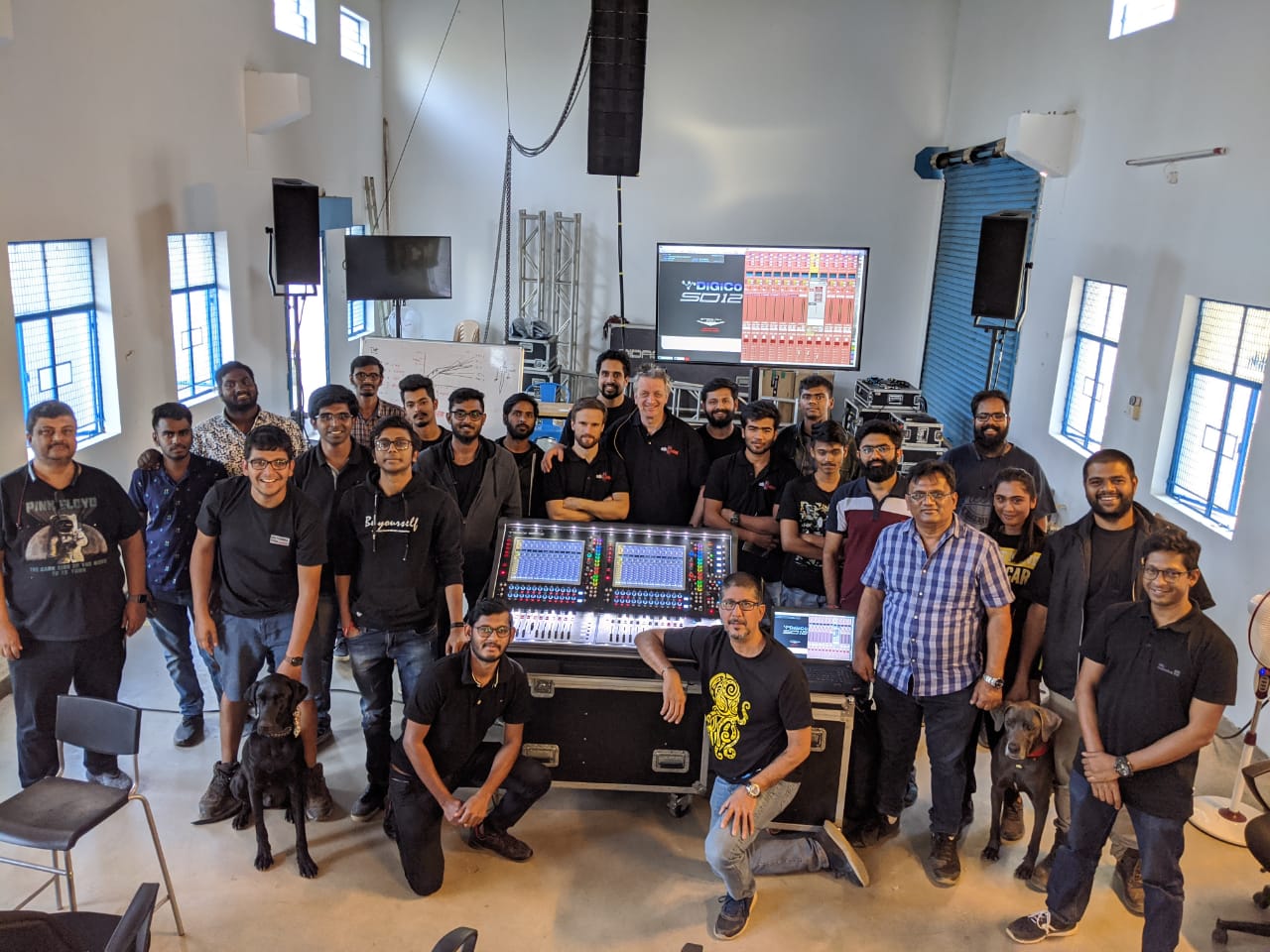Brit Row’s Marcel Van Limbeek and Luca Stefani came to Bangalore to conduct a live sound workshop hosted at Audio Academy. They kicked things off by promptly introducing the attendees to the legacy of Britannia Row.
How the company grew from a small roadie crew for Pink Floyd to a large scale live sound production company over the years is a story to behold. In their many years of working as one of the most prolific live sound companies in the world, they have put together an undeniably efficient way of working.
The effectiveness and uniqueness of their approach had necessitated the need for a detailed training program to ensure the company’s growth. The success of their training program led to collaborations with educational institutions to impart industry knowledge and their wisdom of experience.
The duo came prepared with a week-long schedule to cover the entire live sound process from the point of sales inquiry to show prep to execution and coming back full circle to de prep.
On the first day, they covered the process starting with the sales department up to the point of equipment loadout.
The Sales Department
The face of the company is it’s a highly technical sales team. All decisions made by the sales team are almost never contested by any of the other departments, a testament to their expertise and product knowledge.
During this process, the sales team is in direct contact with the client. The budget for the show is allotted and rough system design by the sales team is used to give an estimate to the client. Once the client agrees to the estimate, the project moves to the operations department.
The Operations Department
The next in the hierarchy is the operations department. They create the inventory list for the job and hand it down to the warehouse where this inventory is prepared. It is updated on a proprietary application called ‘finesse’. The allotment of inventory as well as the organisation of transportation via truck is predetermined by the operations department.

The Warehouse
The warehouse manages all the inventory and is split into its various departments that pertain to specific types of equipment. Once the operations department has compiled the inventory list the process is as follows:
- Pre-Prep: During this process, the warehouse team prepares items for the job depending on the type of the job(load out of equipment). BM is an acronym used for Boards and Monitors where only Mixing Desks and Monitors are supplied on the job. PA is for jobs that only require the speaker systems from the company. During pre-prep, all of this is discussed and items are made ready for prep. For example, the correct count of items is verified and marked on finesse. Even custom racks for amplifiers, speakers and power supplies are made for specific jobs.
- Prep: During the Prep phase, all the items required are assembled, tested and ready. These items are now brought together and are packed, mounted or configured for the required job. This helps in a hassle-free flow of events on the day of production. Finesse usually carries all the updates during every stage. This is beneficial in keeping track of the stock as well as monitoring the completion of each process.
- Load-Out: This is the last step from the warehouse. All the items are loaded onto the appropriate trucks as decided by the operations department. This procedure is taken care of by the warehouse manager who then passes on the responsibility for the event, to the crew chief.
These steps lead to a healthy preparation for any event, big or small.
DAY 2
On the second day of the workshop, Marcel and Luca focused on the complete setup of a live show at the venue. Covering the process from truck load out at the start of the day, to the truckload in at the end of the show. The workflow that Britannia Row Productions follow involves understanding:
The roles of the production crew and communication procedure on the day of the show.
The Production Manager
Plays the role of coordinator for all the independent production teams such as the sound team(the brit row crew) , the lighting crew and the power department. The production manager’s independence renders them unbiased to any of the crew and ensures their authority over the separate teams. The production manager always gets the last word.
The Crew chief
One crew chief from the lighting crew and the sound crew, each, are responsible for carrying out the operations being managed and scheduled by the production manager.
 The process:
The process:
Advancing, A process of scheduling events and planning procedures for a show day happening in the future. This is the primary job of a production manager on tour. Everything, including the truckload and unload, is planned well in advance by the production manager for a smooth flow of events on a show day.
The following steps are followed in a similar order, to set-up a venue for a show:
- Load In: Trucks are unloaded at bays. All the gear is then loaded into the venue at locations pre-defined by the production manager.
- Set-up Preparation: Power is first checked, measured, and connected. Soon after this, a rigging plot created by the system designer will be determined by an external rigging company with the assistance of a system technician. It is a good idea to plan cable runs at this stage as well.
- PA Set-Up: This process is carried out by the system technician, with assistance from freelancing technicians. It is important that speakers get tested before they are flown, to avoid complications.
- FOH Set-Up: An FOH technician is in charge of this process. Once multicores are run, all the equipment at the Front Of House is connected and powered.
- Monitor Set-Up: The monitor technician and the stage manager set-up the monitor world equipment. The Radio Frequency spectrum is scanned for setting-up RF devices as well.
- Stage Set-Up: The stage manager and the stage technician set-up all the equipment on the stage. This includes all the instruments, backline equipment, and cables. Once everything is patched, it is checked at every stage.
- PA Tuning: During this process, the systems engineer tests the PA setup, design, and alignment from various positions-including but not restricted to, the FOH.
- Monitor Tuning: During this process, the stage wedges are checked for feedback using the mics being used on the show. These wedges are then EQ’d accordingly. This process is carried out by the Monitor Technician and the Monitor Engineer.
- Line Check: The FOH engineer, Monitor Engineer, and the Broadcast Engineer work with the stage tech to carry out a thorough line check to ensure all connections have been made.
- Sound Check: After the system is connected and ready, the soundcheck begins. It is during this process that the FOH and Monitor engineers check mixes.
Once this procedure has been carried out the show is ready to begin. During the show, most of the crew is operative, while the Crew Chief plans the de-rigging process over a meeting.
Post-Show
The De-Rig process is usually carried out in the order listed below:
- Stage Equipment Cleared
- Signal Cables Cleared
- Multi-core Cables Cleared
- Subs Cleared
- FOH Cleared
- PA De-Rigged and Cleared
- Trucks Loaded
All of the above processes rely on each other, hence it is important that each of these processes is carried out rapidly, to avoid any delay in the next process. Once these items reach the warehouse, they’re checked in and are de-prepped.
De-prep:
De-prepping is said to be one of the most important procedures as this is when most items are checked and serviced. During this process, it is also determined whether an item will go back on tour or the inventory. Once in the inventory, the same items can be used for another job/show. This process would be in the exact reverse order of the prep procedure.
The meticulous procedure they have developed to ensure a seamless live music production has been a result of years of learning from problems and issues they’ve encountered first hand. A mindset built around creative problem solving and adaptation in an ever-evolving environment is the attitude that has seen the company through from its inception to its long-standing reputation for excellence and reliability.

